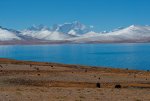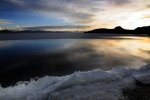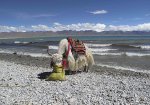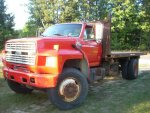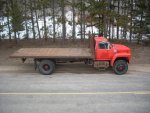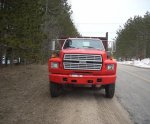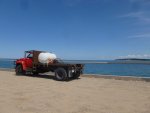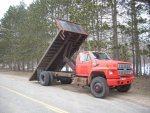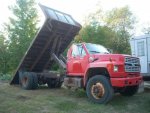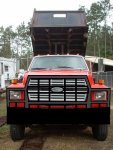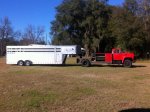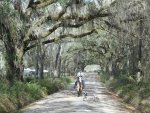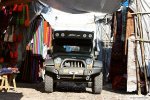.
CONTINUED FROM PREVIOUS POST
********************************************
[video=youtube;bDKY_okeuRM]https://www.youtube.com/watch?v=bDKY_okeuRM&list=PLB8E3F125B4072115&index= 9[/video]
[video=youtube;uM2BkXZCHGk]https://www.youtube.com/watch?v=uM2BkXZCHGk&list=PLB8E3F125B4072115&index= 11[/video]
And see the YouTube channels at
https://www.youtube.com/user/scottrobertsondesign/videos?view=0&shelf_id=1&sort=dd and
https://www.youtube.com/user/krassidimitrov2/videos .
I have been deliberately thinking of my TerraLiner
conceptual design process as similar. In the video below about Ferren's Kiravan, the presenter begins with the suggestion that Ferren's team lost sight of the forest for the trees. They got so caught up with certain details, or certain engineering obsessions -- for instance, that the whole vehicle should able to rock crawl as a unit -- that they ended up with a useless boondoggle:
I am trying to avoid a similar fate for the TerraLiner. Everything affects everything else, so the design of such a vehicle must necessarily be a "holistic" process.
It is wonderful when the domino effect works in one's favor. For instance, drop-down decks with pergola awnings have a number of simultaneous virtues. They massively increase the amount of surface area available for solar cells. They shade the sides of the TerraLiner from the sun, minimizing solar heat gain. When folded up against the sides of the vehicle, they protect and hide the TerraLiner's large windows, shielding them from dust, and from attempted burglary. When retracted and flat against the sides of the TerraLiner, they will make the TerraLiner look like a 3-axle freight truck, pulling a drawbar trailer, thereby exploiting the principle of Vavilovian mimicry. Hence, they are key elements in the visual aspect of TerraLiner security. And when dropped down, the side decks will provide huge outdoor spaces for socializing.
But one only arrives at such "holistic" solutions by relentlessly pursuing a holistic design process, one in which one tries to keep as many balls in the air at the same time as possible. The videos above of concept sketching are the best possible visual metaphors for the process that I have been pursuing.
Sure, I know that conceptual design is one thing, whereas working visually to create a painting or a beautiful sketch is another. But too often designers produce vehicles that are mere "one hit wonders". They push just one aspect of vehicle design a bit further, which is OK, because when huge investments are involved for a big car company, it's best to be conservative. That way one will know whether the new idea works or not. However, the more that I've thought about the TerraLiner, the more it has seemed that by being courageous and pushing the envelope on all fronts simultaneously, completely new "system synergies" will emerge, and open up new possibilities. For instance, a 300 KW generator is not only important to power a serial hybrid drivetrain, but along with the 300 KW battery pack it opens up the possibility of "mostly silent" camping. And that's important operationally and logistically, because without it, a farmer might think twice about renting his land, because the TerraLiner would be too noisy.
So working more "holistically", and developing the TerraLiner conceptually in much the same way as I would a concept sketch or painting, has become a deliberate process. I have been constantly going back and forth across various concerns, structural, driveline, security, logistics, camping autonomy, etc., seeing how a development in one area might affect another. I am doing this for fun, and I have no deadline to meet anymore. My MFA thesis project was a funky design that my tutors loved, but would have been completely unworkable in the real world. I would never post it here, because it would just get laughed at, as it should. For instance, it certainly did not incorporate the idea of "Vavilovian mimicry", i.e. deliberately designing the exterior of the TerraLiner so that it looks like a slightly fashion-forward three-axle freight truck, pulling a drawbar trailer. So now that I'm doing a Ph.D and have quite a bit of free time on my hands, I can afford to continue "conceptual sketching" in a holistic way.
************************************************
2. Thanks for the excellent reference to Sion Batteries
************************************************
Many thanks for the lead on Sion batteries.
But I found one interesting information.
http://www.sionpower.com/vehicles.html
They claim to be able to do a 54 kWh battery pack with a weight of 475 lbs. That's a notch over 250 Wh/kg, much better than Tesla thanks to a denser chemistry. The cells themselves are 350 Wh/kg.
There are no charge / discharge rates provided though.
http://www.sionpower.com/pdf/articles/Las Vegas 2005 PBFC.pdf shows a charge plot at 0.15C and discharge at 0.33C
http://www.sionpower.com/pdf/articles/PowerSources2004.pdf shows discharge at 3C
http://sionpower.com/pdf/articles/SionPowerECS.pdf claims "Charge in less than 3 hours"
So it allows to be charged at 0.33 C, maybe faster and discharged at 3C, maybe faster.
I believe I've seen their cell specs before, with currents included. Wayback machine doesn't help so far....
ADDED:
http://longtailpipe.com/2015/11/24/...al-batteries-will-give-us-200-mile-range-evs/ shows that in 2018 they plan to have fast-charge cells with 295 Wh/kg. No mention of what is 'fast'.
ADDED:
It's incredible, but SiIon doesn't provide a contact e-mail address...
Perhaps from a design point of view this means we should plan for a 400 KW battery pack, circa 2020. The charge rate is a concern, because as you know, we have to keep the farmer happy. But 300 Wh/kg means that a 400 KW battery pack would weigh just 1,333 kg. It would weigh 170 kg less than the 300 KW Tesla battery pack that we discussed earlier, and yet would provide 25 % more electricity. Just as long as C could be brought as close as possible to 1 when charging. Even if such a battery pack were available only in 2022, and not 2020, it might be a good idea to design with it in mind, "in anticipation". A 300 KW Tesla battery pack that discharges and charges at 1 C, and that gets 200 Wh/kg seems a virtual inevitability by 2020. So maybe the best way forward would be to design with that as guaranteed, but with enough space to accommodate 400 KW Sion batteries by 2022.
Of course, even if C when charging were 1, it will take longer for a 300 KW generator to recharge 400 KW. But if recharging C were 1, the recharge time could still be kept to under two hours, even after we factor in all the inefficiencies. The number of days of absolute silence between 2-hour recharging periods will be important. If the time between generator runs could be 4 days when solar is poor, instead of 3 days, all the better. It's all about keeping the farmer -- and any other potential neighbors -- very happy, even though the TerraLiner will be a high-energy-usage vehicle when camping in hot climates, because of A/C.
************************************************
3. The Braking Potential of the TerraLiner TOAD
************************************************
I have already answered your fuel comment: the TerraLiner will sometimes glamp in places where there is no farmer, and no nearby gas staiion. And I've answered the mountain-driving issue: coastal highways often drive through mountainous terrain, and they go up and down, even if they also go through tunnels. So too, the TerraLiner will definitely want to visit high-altitude mountain lakes, because it's a
"water glamper", and not just a
"surf glamper".
But your 1300 HP question remains in the air.
A thought just occurred to me: the TerraLiner actually has 6 axles, not 3. There are 3 axles on the main vehicle, but at least another 2 and perhaps 3 axles on the TOAD garage trailer. Originally I thought of the trailer as having hydrostatic motors so it could be autonomously repositioned. But as
thjakits pointed out, why not go all-electric, even with the trailer, too? The trailer will not have its own generator, but it could have an additional battery pack. And perhaps the main purpose of the trailer's electric motors would be to serve as brakes when descending inclines.
These might best be hub motors, because we will need the space running down the center of the trailer to accommodate the flattened RIB, in a V-shaped slot that's about 80 cm high, 1.5 m wide, and 5.5 to 6 m long. So straight axles across the width of the trailer might make a "RIB garage" located directly underneath the TOAD garage impossible. Or perhaps it's the other way around? Perhaps the complexity of independent suspension would block the possibility of such a RIB garage? Honestly, I have no idea, and it seems like things could go either way.
In the image of the independent suspension by AxleTech that
Haf-E posted, I noticed that there's a really wonderful "V"-shape right in the center, of exactly the kind that the TerraLiner's RIB garage could exploit:

See posts #2347 and #2348 at
http://www.expeditionportal.com/for...w-6x6-Hybrid-Drivetrain?p=2009888#post2009888 . The bottom of the V-shaped notch seems to be only about 10 - 20 cm above the wheel centers. So if the wheel centers were at about 60 cm above grade when the TerraLiner is fully loaded (assuming the big Michelin XZL tires), then the bottom of the notch would be 80 cm above grade. So this would allow for a RIB garage that's 80 cm high, or thereabouts, underneath the floor of the TOAD garage, which would be 1.6 m above grade. Also remember that the suspension in the TOAD garage does not necessarily have to be the same as, or as sophisticated as, the suspension in the main vehicle. Sure, it needs to handle washboard. But progressive coil with air-bags might be enough. Perhaps no need for hydro-pneumatic suspension. The trailer will not be carrying any passengers, only the TOAD and various water toys.
Theoretically, 6 additional hub motors, if they were Wrightspeed 250 HP motors, could add an additional 1500 HP of braking power. The TerraLiner's combined electric motors, main vehicle + trailer, would then have
much more power than the generators, about 2800 HP in total. Or, circa 2020, if 500 HP Tesla motors were available, it would have 3000 HP of potential regenerative braking power. Even if the TOAD garage trailer also had just three Tesla 500 HP motors instead of six Wrightspeed motors, combined braking power would still be 3000 HP. If the TOAD had two axles instead of three, then braking power would be 2500 HP. As we've agreed, in the world of electric hybrid vehicles lots of HP in the electric motors is a good thing. The HP is for braking, not propulsion. The only possible issue might be the size of the electric cable running from the main vehicle to the Trailer: it would have to be huge. Again, there would be no independent generator on the trailer, just a battery pack.
Would 3000 HP of potential braking power be necessary for a 32 ton TerraLiner, when descending extended inclines? I don't know how to do the math on this. There's also the issue of how to dissipate the energy generated. A 300 KW battery pack will only be able to absorb some of the energy. In a hot climate one could run the TerraLiner's air-conditioning units full blast, so that they chill the interior of the TerraLiner to a ridiculously high level, bringing the interior temperature down to 5 - 10 degrees Celsius, even though the Heat Index outside is 110 Fahrenheit. Once at the bottom of the incline, and once arrived at a new campsite, raising the interior temperature would be easy: just open all the windows and doors, to let 110 Heat Index air blow through.
In cold climates, the anti-snow heating elements on the roof could be turned on to the max, so that they are not just melting snow, but are also massively dissipating heat into the cold atmosphere. So getting rid of excess energy in either very hot or very cold climates might not be a problem. The biggest problem might arise in more moderate climates.
What do you think?
All best wishes,
Biotect


